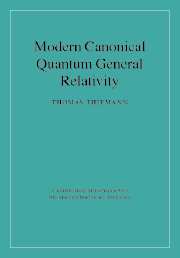Book contents
- Frontmatter
- Contents
- Foreword, by Chris Isham
- Preface
- Notation and conventions
- Introduction: Defining quantum gravity
- I CLASSICAL FOUNDATIONS, INTERPRETATION AND THE CANONICAL QUANTISATION PROGRAMME
- II FOUNDATIONS OF MODERN CANONICAL QUANTUM GENERAL RELATIVITY
- III PHYSICAL APPLICATIONS
- 12 Extension to standard matter
- 13 Kinematical geometrical operators
- 14 Spin foam models
- 15 Quantum black hole physics
- 16 Applications to particle physics and quantum cosmology
- 17 Loop Quantum Gravity phenomenology
- IV MATHEMATICAL TOOLS AND THEIR CONNECTION TO PHYSICS
- References
- Index
16 - Applications to particle physics and quantum cosmology
Published online by Cambridge University Press: 04 August 2010
- Frontmatter
- Contents
- Foreword, by Chris Isham
- Preface
- Notation and conventions
- Introduction: Defining quantum gravity
- I CLASSICAL FOUNDATIONS, INTERPRETATION AND THE CANONICAL QUANTISATION PROGRAMME
- II FOUNDATIONS OF MODERN CANONICAL QUANTUM GENERAL RELATIVITY
- III PHYSICAL APPLICATIONS
- 12 Extension to standard matter
- 13 Kinematical geometrical operators
- 14 Spin foam models
- 15 Quantum black hole physics
- 16 Applications to particle physics and quantum cosmology
- 17 Loop Quantum Gravity phenomenology
- IV MATHEMATICAL TOOLS AND THEIR CONNECTION TO PHYSICS
- References
- Index
Summary
Quantum gauge fixing
Applications of Loop Quantum Gravity to Particle Physics (see A. [637, 638] in the canonical framework where scalar, electromagnetic and fermionic-free matter propagation on fluctuating quantum spacetimes is studied, B. [773,774, 836–839] in the 4D spin foam framework where graviton propagators are studied and C. [724, 840, 841] in the 3D spin foam framework where the relation with Feynman diagrams is studied) and Quantum Cosmology (see [834, 835] for the full theory where the homogeneous sector has been studied; for homogeneous minisuperspace models see the next section) have just begun. This important research area is so far little explored because ideally one would need to have sufficient control over the physical Hilbert space. Since this is not yet the case, one must think about approximation schemes in order to make progress. As a possible starting point or approximation scheme one could use the kinematical, semiclassical framework developed in Chapter 11: namely, if we use states which are peaked on points in the phase space that solve the constraints, then the expectation value of the constraints in these states is either exactly or close to zero and the fluctuations are small in a suitable sense. Hence, while the states are not physical states, even the norm of the constraints on those states is small. They are therefore approximately physical states.
Notice that kinematical semiclassical states are labelled by a point on the constraint surface contained in some gauge orbit but not by the gauge orbit itself. In other words, we must choose a classical gauge fixing, that is, a section of the bundle whose total space is the constraint surface, whose fibres are the gauge orbits and whose base space is the reduced phase space.
Information
- Type
- Chapter
- Information
- Modern Canonical Quantum General Relativity , pp. 562 - 571Publisher: Cambridge University PressPrint publication year: 2007
